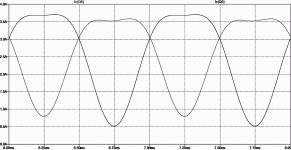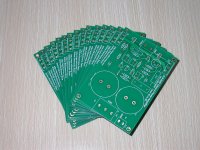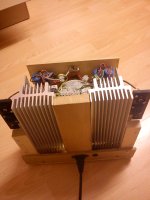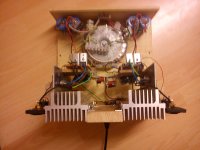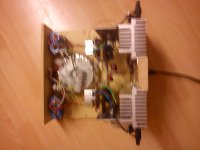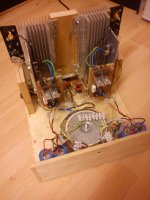To do the matching properly, you need to match hfe at the working bias.
Not in cases where beta droop will be the dominant flaw.
Base currents at peak output in greatest need of a match.
Base currents balance in quiescent state are completely
manageable by the combo of global loop and offset CCS.
If quiescent HFE doesn't match, bothers almost nothing.
But the maximum base current here is fixed by Q8, and
this loop can't to jack to fix it if the maximum currents
required by output bases do not match.
If one 2n3055 peak flattens earlier than other, match
at any lesser current won't give you that information.
This example is slightly exaggerated, but not by much.
Attachments
Last edited:
>
I wonder if it is your experience that the output transistors have negative tempco and therefore there is no danger of thermal run-awy or the necessity of the lower transistor to thermally track the upper one for output DC stability ? Or you have a means of thermal tracking using separate heatsinks that you are willing to share with us ?
JLH probably abused beta droop of old style power devices
to control thermal runaway. Look at OnSemi datasheet for
2n3055, and observe all temperature curves meet at 4.5A.
Also note how the higher temp droops at the faster rate...
This won't protect newer better devices that aren't driven
into droop. Gain just keeps going up with temp...
----
Yeah, I got a method of thermal tracking I can share.
http://www.diyaudio.com/forums/solid-state/197707-shunt-regulated-jlh.html
Best was probably the version presented at post #22.
I don't want to waste my time tracking thermals and hope
the curves somehow cancel. Instead I will make darn sure
both output currents are forced equal and opposite, and the
sum is held to a reference that shrinks with temperature.
You don't want to mess with matching pairs, adjusting
bias and offset, and worrying about droop vs runaway?
I believe all can be done with one less transistor than
JLH-2005, and works in simulation. The prototype still
a pile of parts in my kitchen, so I can't say for sure yet.
One I get the bugs (if any) worked out of SRJLH-2012,
I don't mind anyone wants to make a PCB. I have no
experience in layout. All my peers at work prefer I stay
busy in the test lab, and don't bother our layout guys
with such questions.
Last edited:
Today I'm sooooo happy with the testing result. After the following modifications of the original first design I posted:
1. VR1 changed to 100R
2. R13 changed to 10R
3. Q3 changed to BD139
The amplifier is working great! At the beginning the THD is 1% @1KHz/1W/8Ohm, pretty high for a class-A. I realize that Q1 and Q2 should be paired matched. Then I changed them with 2 pair matched transistors, the THD drops to 0.05%!
I also tried with some other transistors such as 2N3055, 2N3773 and finally 2SC5200. In my own opinion I like the sound of 2SC3280 most, high freq is very clear.
BD139 and BD140 works great in the testing. I think it's no need to worry about the high current. The don't have a heatsink and were slightly warm during working.
Hope your guys can also build a great amplifier when you receive my free PCBs.
I am very curious to know how hot that heat sink gets. If I would guess it would be around 90 degrees centigrade or even higher after a few minutes. If the heat sink can be touched, you are not running near the bias current that you should be.
It's depend on which heatsink to use. When mounted on a small heatsink, it can boiling water after 20 minutes. With a large heatsink the temp won't be over 70C even after a few hours.
I am very curious to know how hot that heat sink gets. If I would guess it would be around 90 degrees centigrade or even higher after a few minutes. If the heat sink can be touched, you are not running near the bias current that you should be.
New boards fab out
New version PCB is fab out!
Modifications:
1. connected collectors of Q8 and Q3 (which was missing on the first version)
2. modified footprint of potentiometers. Multi turn pots can also be mounted
3. fixed the bug of small hole for Q8.
4. added a 220uf cap on feedback path. This is an optional component.If you don't need it just short 2 pins of the cap
5. footprint of Q1 and Q2 are modified to which TO-3PL transistors like 2SC3280 can be assembly on board directly.
Free boards keep on offering:
FREE JLH -2005 Class-A Amplifier Board - Boards | Kits | Components | Modules | Tools
Also thinking about add a tube into a JLH design. Any suggestions?
New version PCB is fab out!
Modifications:
1. connected collectors of Q8 and Q3 (which was missing on the first version)
2. modified footprint of potentiometers. Multi turn pots can also be mounted
3. fixed the bug of small hole for Q8.
4. added a 220uf cap on feedback path. This is an optional component.If you don't need it just short 2 pins of the cap
5. footprint of Q1 and Q2 are modified to which TO-3PL transistors like 2SC3280 can be assembly on board directly.
Free boards keep on offering:
FREE JLH -2005 Class-A Amplifier Board - Boards | Kits | Components | Modules | Tools
Also thinking about add a tube into a JLH design. Any suggestions?
Attachments
I just ordered 2 PCBs
There is space for reviews on his website.
I cannot see any reviews from Forum Members !!!
Maybe your glasses are steaming up again Andrew
Regards
Ian
Finally built a chassis (sort of) for my JLH.
Still needs some covering up before it's allowed in the house as a permanent feature.
There's still a tiny amount of hum, which I can live with, and sometimes a weird buzzing when a phono input is half plugged in - I suspect to do with a lack of ground connection from the source somehow. Anyway, not an issue really.
Also quite reassured by the fact it weighs 9.3kg.
Still needs some covering up before it's allowed in the house as a permanent feature.
There's still a tiny amount of hum, which I can live with, and sometimes a weird buzzing when a phono input is half plugged in - I suspect to do with a lack of ground connection from the source somehow. Anyway, not an issue really.
Also quite reassured by the fact it weighs 9.3kg.
Attachments
You never know, I might use my camera to take a photo one day - rather than my wobbly phone.
I do not know the technical reason it may not be a good practice to subject power lines to the magnetic field of a transformer. But I am pretty sure that it would not do any harm to lay out power lines away from the transformer if possible.
Sorry for my worry too much noise plus I have no proper electronic education et al.
Hi Chris,
You're right, it might be possible there's induced hum, but I think the hum (not that there is much at all - only when there's no signal and you're really close to the speaker) can probably be reduced with further capcitance and possibly some filtering (basically CRC filtering). The weird noise I can only guess is a grounding issue of some sort.
Cheers,
Phil
You're right, it might be possible there's induced hum, but I think the hum (not that there is much at all - only when there's no signal and you're really close to the speaker) can probably be reduced with further capcitance and possibly some filtering (basically CRC filtering). The weird noise I can only guess is a grounding issue of some sort.
Cheers,
Phil
- Home
- Amplifiers
- Solid State
- JLH 10 Watt class A amplifier
